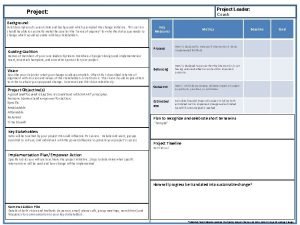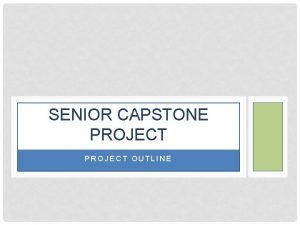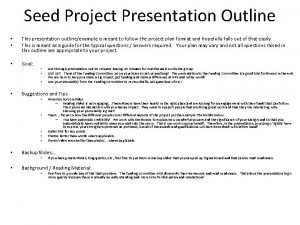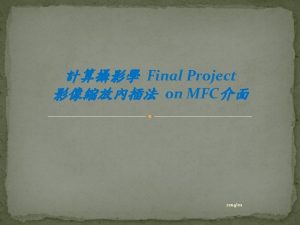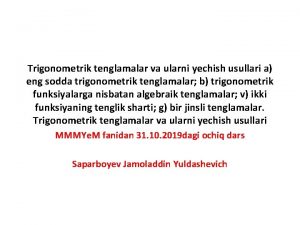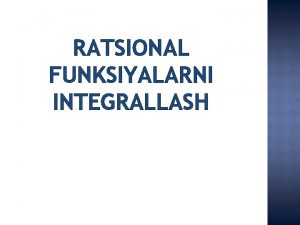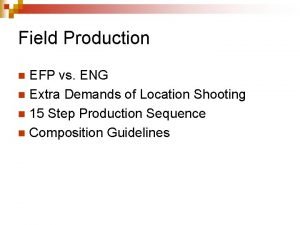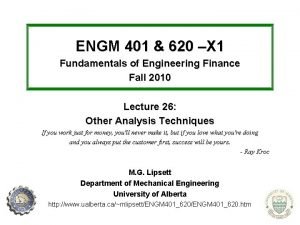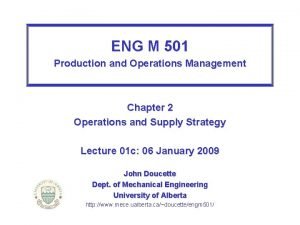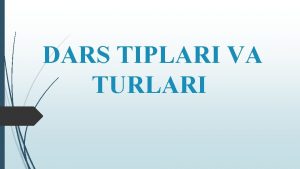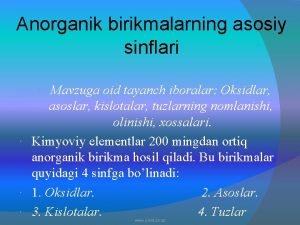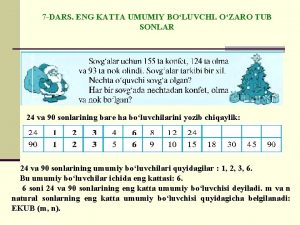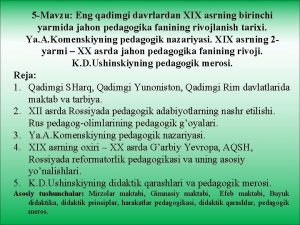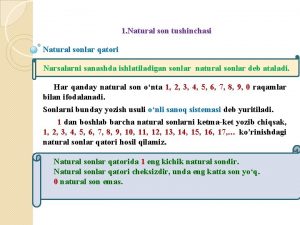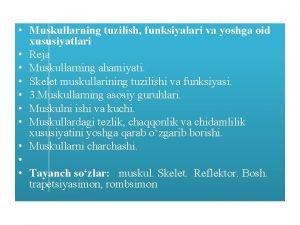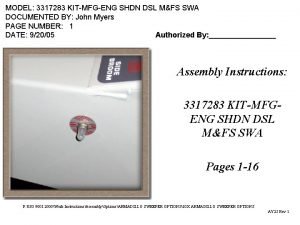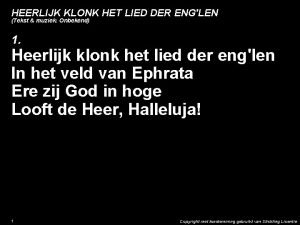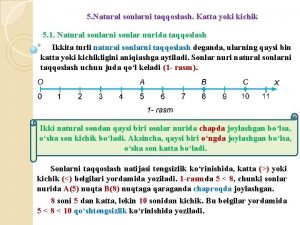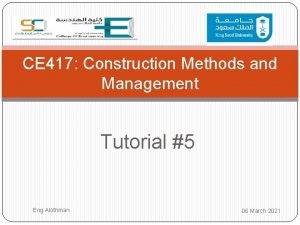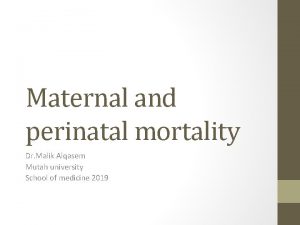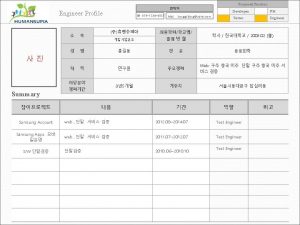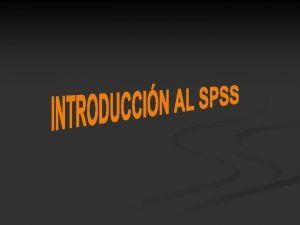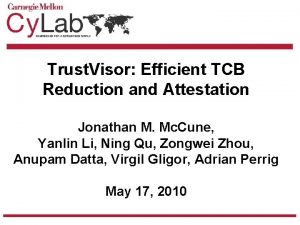Super Visor Eng Emad Alqasem Outline Project description

































































- Slides: 65

Super Visor: Eng. Emad Al-qasem

Outline � Project description � Philosophy of analysis & design � Design Of Slab � Design Of Beam � 3 -D Model � Design of column � Design of footing � Dynamic analysis

Project description �Faculty of science building in king Khalid university located in Saudi Arabia. �Area of the part that we take to design = 7250 m 2



Philosophy of analysis & design �Ultimate design method is used to analysis and design of one way solid slab �the slab are carried over drop beams �Columns carrying an axial loads calculated by tributary area

materials of construction �Reinforced concrete �The unit weight of concrete ( ) = 25 k. N/m 3. �The required compressive strength after 28 days is fc = 28 MPa. �The yield steel bars required Fy = 420 MPa.

Code used �American concrete institute code (ACI 318 -08) � 2009 International Building Code (IBC )

Loads Dead load: � Own weight for slab = 6. 25 k. N/m 2. � Super imposed load = 3. 44 k. N/m 2. Live load: �for Garage = 3 KN m 2. �for all the class room = 2. 4 KN m 2. �for corridors = 4. 8 KN m 2.

Load Combination �Ultimate load = 1. 2 D+1. 6 L Where: D: dead load L: live load

Design Of Slab

Slab �One way solid slab is used in the building �slab thickness is determined according to deflection control according to ACI code �Minimum thickness = Ln/24 = 22 cm thickness used = 25 cm

Check shear for slab �Ln max = 6 - 0. 4 = 5. 6 m �Vu =42. 5 k. N at distance d from face of column. � Vc =0. 75*0. 166*(28)1 2 *1000*220/1000 = 145 k. N 145 > 42. 5 ……… OK

Part A Strip Distribution of sub terrain floor

Part A Strip Distribution of ground , first & second floor

Part B Strip Distribution of sub terrain floor

Part B Strip Distribution of Ground & First floor

Part B Strip Distribution of second floor

Part B Strip Distribution of third floor

Part C Strip Distribution of sub terrain floor

Part C Strip Distribution of Ground , First & second floor

Design of strip 1 of sub terrain floor of part (A)


Design Of Beam

�Beams designed using tributary area method. �All beams are dropped. �T & L Section used.

Part A Beams in sub terrain floor

Part A Beams in ground , first & second floor

Part A Beams in third floor

Part B Beams in sub terrain floor

Part B Beams in ground & first floor

Part B Beams in second floor

Part B Beams in third floor

Part C Beams in sub terrain floor

Part C Beams in ground & first floor

Part C Beams in second floor

Design beam 1 of ground floor Of part (A)

Av/s =1. 864 S= 80 mm

3 -D Model Part A

Part B

Part C

Required Checks �Compatibility Check �Equilibrium Check �Stress-Strain Relationships

Check compatibility: �This requires that the structure behave as one unit

Equilibrium Check Part C Load Type Hand Calculation From SAP % of Error Live Load 22987. 4 23898 3. 9 Superimposed load 19633 19927 1. 5 Dead Load 73829 77101 4. 4

Design Of Column

Columns are divided into five groups : Each group include columns with ultimate axial load : � group 1 (800 2500) k. N, � group 2 (2500 4000) k. N, � group 3 (4000 5500) k. N, � group 4 (5500 7000) k. N, � and group 5 (7000 8500) k. N.

Check buckling �If KL/r ≤ 34 -12 (M 1/M 2) the column is short � KL/r = 1(4. 5)/0. 3(0. 8) = 18. 75 < 22 �Can be considered as short column

Design of columns in group (1): �ɸPn = ɸλ {0. 85 fˋc(Ag-Ast) + Fy. Ast} � 2500 x 103=0. 65 x 0. 8{0. 85 x 40(Ag-0. 01 Ag)+420 x 0. 01 Ag} �Ag =1270 Cm 2 � Use 40*40 ……… Ag =1600 Cm 2 �Ast=0. 01 x 160000=1600 mm 2 (use 4ɸ 25 mm)

�Spacing between stirrups: �S ≤ At least dimension of the column = 40 cm 16 db =16 x 2. 5=40 cm 45 ds =45 x 1 =45 cm �Ties (1ɸ 10 mm/40 cm)

Design Of Footing

selection of footing �Since the area of all single footings >> 60% the area of building �Then using mat foundation

Mat foundation: �this type of foundation is used when the allowable bearing capacity of soil is very low and very large load on it.

�To calculate the effective depth (d) check punching shear has been used Part A � VC =0. 75(1/3)f`C 1/2 bod �Assume d=1. 25 m � VC =0. 75(1/3)(28)1/2(4600)(1250)/1000=7607 k. N>Pu

�Part B �Assume d=1. 0 m � VC =0. 75(1/3)(28)1/2(6800)(1000)/1000=8995 k. N>Pu �Part C �Assume d=1. 1 m � VC =0. 75(1/3)(28)1/2(4000)(1100)/1000=5820 k. N>Pu

Ultimate bending moment (m 11) of part A

Ultimate bending moment (m 22) of part A

Reinforcement for part A � Take the moment from SAP to compute the reinforcement � min= 0. 0018 (b*h)/(b*d) = 0. 0018 (1000*1400)/(1000*1250) = 0. 002 Mu using ( min = 0. 002) = 1162 k. N. m > Mu from SAP � Using As min in both direction (1ɸ 18/100)

Dynamic Analysis

�Dynamic analysis can be used to find dynamic displacements, time history, and modal analysis. �Response spectrum method will be used for seismic analysis as provided in Uniform Building Code for year 97 (UBC 97).

Ca & Cv

Scale factor �Scale factor = g I / Rp = 9. 81 *1. 25 /3 =4


Maximum displacement: From seismic load: (ex) part (A)

Maximum displacement: From seismic load: (e. Y) part (A)

Maximum displacement: From seismic load: (ez) part (A)

Thanks For Listening
 Supervisor access chapter 1
Supervisor access chapter 1 Shartli ekstremum
Shartli ekstremum What is the poetry of earth
What is the poetry of earth Emad farrag
Emad farrag Emad eskandar md
Emad eskandar md Emad tipo 1
Emad tipo 1 Emad george
Emad george Superworm is super strong
Superworm is super strong Visor de contratos
Visor de contratos Visor infogis aragón incendios
Visor infogis aragón incendios Caldwell technique vestibuloplasty
Caldwell technique vestibuloplasty Visor gml registradores madrid
Visor gml registradores madrid Visor de contratos udg
Visor de contratos udg Yamalube visor and helmet cleaner
Yamalube visor and helmet cleaner Gmlweb visor
Gmlweb visor Cloud visor
Cloud visor Visor xsig
Visor xsig Sentence outline examples
Sentence outline examples Brief description of the project
Brief description of the project Example project title
Example project title Brief description of the project
Brief description of the project Multimedia project definition
Multimedia project definition Senior project outline
Senior project outline Capstone outline
Capstone outline Investigatory research
Investigatory research Project presentation outline
Project presentation outline Bsb51407
Bsb51407 Project presentation outline
Project presentation outline Laplacian pyramid
Laplacian pyramid Eng sodda trigonometrik tenglamalar ppt
Eng sodda trigonometrik tenglamalar ppt Numericalmethods.eng.usf.edu
Numericalmethods.eng.usf.edu Ratsional funksiya
Ratsional funksiya Eng efp camera
Eng efp camera English pearson portal
English pearson portal Sinab
Sinab Eng qadimgi davrlarda tarbiyaning kelib chiqishi
Eng qadimgi davrlarda tarbiyaning kelib chiqishi Dse english weighting
Dse english weighting English language paper 2 transactional writing
English language paper 2 transactional writing Efp vs eng
Efp vs eng Eng m 401
Eng m 401 Eng m 501
Eng m 501 Examples of electronic news gathering
Examples of electronic news gathering Dse 2015 eng
Dse 2015 eng Kasb tiplari
Kasb tiplari Http://numericalmethods.eng.usf.edu
Http://numericalmethods.eng.usf.edu Avestoni o'rgangan olimlar
Avestoni o'rgangan olimlar O'zgarmas valentli elementlar
O'zgarmas valentli elementlar Ekub topish
Ekub topish Afinada maktab tizimi
Afinada maktab tizimi Uzunlikka sakrash turlari
Uzunlikka sakrash turlari Sonlarni yozishda nechta raqam ishlatiladi
Sonlarni yozishda nechta raqam ishlatiladi Engineering notation symbols
Engineering notation symbols Fonemaning eng muhim belgisi
Fonemaning eng muhim belgisi Orqaning yuz muskullari
Orqaning yuz muskullari Eng shdn
Eng shdn Ravon nutqni rivojlantirish referat
Ravon nutqni rivojlantirish referat Fuqarolik tarbiyasi axloqiy tarbiya
Fuqarolik tarbiyasi axloqiy tarbiya Heerlijk klonk het lied der eng'len
Heerlijk klonk het lied der eng'len Sonlar nuri nima
Sonlar nuri nima Qattiq jismning aylanma harakati
Qattiq jismning aylanma harakati Ip-eng-001
Ip-eng-001 Axborot nima
Axborot nima Axborot qanday sifatlarga ega bo'lishi kerak
Axborot qanday sifatlarga ega bo'lishi kerak سیگنال eng
سیگنال eng Coefficient of traction for crawler tractor
Coefficient of traction for crawler tractor Eng 1112
Eng 1112




















